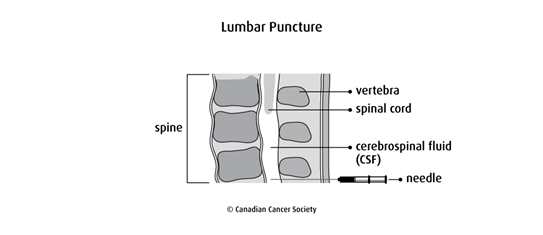Chemotherapy for childhood non-Hodgkin lymphoma
Chemotherapy uses anticancer (cytotoxic) drugs to destroy cancer cells. It is the main treatment for childhood non-Hodgkin lymphoma (NHL). The healthcare team will consider the type of NHL, the stage, the risk group and your child’s personal needs to plan the drugs, doses and schedules of chemotherapy. Your child may also receive other treatments.
Chemotherapy is given for different reasons. Your child may have chemotherapy to:
- destroy cancer cells in the body
- prevent the spread of cancer cells to the brain and spinal cord (called the central nervous system, or CNS)
- prepare for a stem cell transplant
Chemotherapy is usually a systemic therapy. This means that the drugs travel through the bloodstream to reach and destroy cancer cells all over the body. The drugs are often given through a needle in a vein (intravenously). Your child may need intense chemotherapy and a special device called a central venous catheter may be used to safely give the drugs. It is usually placed during surgery at the start of chemotherapy and left in place until treatment is finished.
Chemotherapy may also be a regional therapy, which means that it is given to a specific area of the body. Some children with NHL may need chemotherapy to the CNS to prevent NHL from spreading to the CNS or to treat NHL that has spread to the CNS. Chemotherapy is given to the CNS using intrathecal chemotherapy.
Intrathecal chemotherapy is given through a lumbar puncture( spinal tap) into the space around the spinal cord that contains the cerebrospinal fluid (CSF).

Chemotherapy drugs used for childhood NHL
Chemotherapy drugs used to treat childhood NHL include:
- cyclophosphamide (Procytox)
- doxorubicin (Adriamycin)
- vincristine (Oncovin)
- cytarabine (Cytosar)
- methotrexate
- prednisone
- dexamethasone (Decadron, Dexasone)
- daunorubicin (Cerubidine, daunomycin)
- asparaginase (Kidrolase)
- etoposide (Vepesid, VP-16)
- mercaptopurine (Purinethol)
- ifosfamide (Ifex)
- leucovorin (folinic acid)
- thioguanine (Lanvis)
- vinblastine
Targeted therapy with rituximab (Rituxan) may be given along with chemotherapy.
Intrathecal chemotherapy can include 1 to 3 of the following drugs:
- methotrexate
- cytarabine
- hydrocortisone
If childhood NHL does not respond to drugs used in earlier treatments or if it comes back, the following drug combinations may be used:
- ifosfamide, carboplatin, etoposide and rituximab
- ifosfamide, carboplatin (Paraplatin, Paraplatin AQ) and etoposide
- dexamethasone, etoposide, cisplatin, cytarabine and asparaginase
- vinblastine
Side effects
Side effects can happen with any type of treatment for childhood NHL, but every child’s experience is different. Some children have many side effects. Other children have only a few side effects.
Chemotherapy may cause side effects because it can damage healthy cells as it kills cancer cells. Side effects can happen any time during, immediately after or a few days or weeks after chemotherapy. Sometimes late side effects develop months or years after chemotherapy. Most side effects go away on their own or can be treated, but some side effects may last a long time or become permanent.
It is hard to say exactly which side effects a child will have, how long they will last and when the child will recover. A child’s body seems to handle chemotherapy better than an adult’s body. Children usually have less severe side effects and will often recover from them faster than adults.
Side effects of chemotherapy will depend mainly on the type of drug, the dose, how it’s given and your child’s overall health. Some common side effects of chemotherapy drugs used for childhood NHL are:
- tumour lysis syndrome
- bone marrow suppression causing low platelet count, low white blood cell count and anemia
- hair loss
- sore mouth or throat
- loss of appetite and taste changes
- nausea and vomiting
- diarrhea
- weight gain or loss
- fatigue
- constipation
- skin problems
- peripheral nerve damage
Chemotherapy for certain types of NHL can be quite intensive. Your child may need to stay in the hospital for a long time to reduce the risk of serious or life-threatening infections because of an impaired immune system.
Other side effects can develop months or years after treatment for childhood NHL. Find out more about late effects for childhood NHL.
Tell your child’s healthcare team if your child has these side effects or others you think might be from chemotherapy. The sooner you tell them of any problems, the sooner they can suggest ways to help your child deal with them.
Information about specific cancer drugs
Details on specific drugs change regularly. Find out more about sources of drug information and where to get details on specific drugs.
Questions to ask about chemotherapy
Find out more about chemotherapy and side effects of chemotherapy. To make the decisions that are right for your child, ask the healthcare team questions about chemotherapy.
Your trusted source for accurate cancer information
With support from readers like you, we can continue to provide the highest quality cancer information for over 100 types of cancer.
We’re here to ensure easy access to accurate cancer information for you and the millions of people who visit this website every year. But we can’t do it alone.
Every donation helps fund reliable cancer information, compassionate support services and the most promising research. Please give today because every contribution counts. Thank you.
